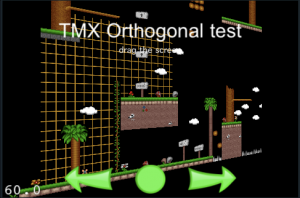Learning cocos2d with samples
Published by on March 3, 2010 in cocos2d. 9 Comments

Arguably the most unknown cocos2d feature is the tests/samples.
cocos2d contains almost a test for each feature that it has. These tests are grouped by component. eg:
- Sprite Test: It tests the
CCSpriteandCCSpriteSheetfunctionality like anchorPoint, visibility, parenting, reordering, honor Transform, etc… - Action Test: It tests the
CCMove, CCRotate, CCTint, CCCamera, CCSequence, CCSpawn, etc.. - Menu Test: It tests all kind of menus
- CocosDenshion: It tests the Sound Engine
- Chipmunk Accel Touch Test: It tests integration with Chipmunk physics engine using accelerometer and multi touches.
- Particle Test: It tests all kind of particles (quad particles, point particles, sun, meteor, galaxy, smoke, fire, etc…)
- etc…
Although these tests were coded for testing purposes they can also be used as examples. Not only they use the API in the recommended way, but some of them, also contain useful tips in the commentaries.
In order to run the tests, you should do:
- Open the cocos2d Xcode project
- Select the test target: Xcode -> Project -> Set Active Target -> eg: TransitionTest
- Make sure that the running executable is correct: Xcode -> Project -> Set Active Executable -> eg: TransitionTest
- Build and run: Xcode -> Build and run
Another quick way of doing it by customizing the toolbar:
- Xcode -> Right click on the toolbar -> Customize Toolbar
- Drag & drop the Active Target button to the toolbar
- Drag & drop the Active Executable button to the toolbar

The source code of the samples are in the tests subdirectory.
So, let’s say you want to learn how to use Tiled maps. What you should do is:
- Select the TileMapTest target
- Make sure that the TileMapTest executable is selected
- Build & Run.
- Try all the subtests. The TileMapTest has more than 10 subtests. Eg: Hexagonal test, Isometric test, Orthogonal tests, read-write tile tests, etc…
- See the TileMapTest source code: tests/TileMapTest.m
- Modify the source code and go to step 2.









 本文详细介绍cocos2d的内置测试用例作为学习资源,包括精灵、动作、菜单等功能测试,以及如何通过修改示例代码来自学Tiled地图等进阶技巧。
本文详细介绍cocos2d的内置测试用例作为学习资源,包括精灵、动作、菜单等功能测试,以及如何通过修改示例代码来自学Tiled地图等进阶技巧。

















 被折叠的 条评论
为什么被折叠?
被折叠的 条评论
为什么被折叠?








